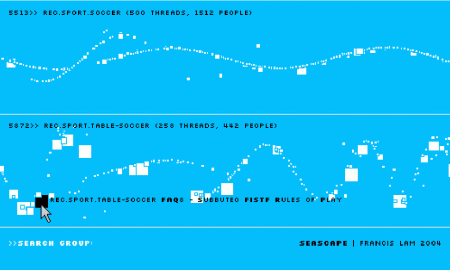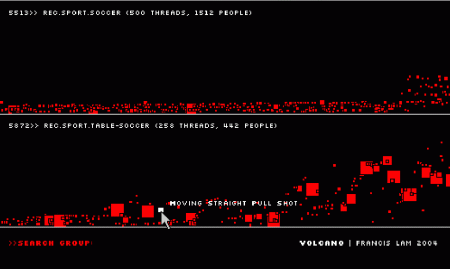Graphs and charts are moving
Researchers at the Massachusetts Institute of Technology have found a way to display activity in newsgroups on interactive animated charts. According to scientists, they are much more informative than static diagrams, and in the future animated graphs will be a standard element of any presentation.
A study by scientists at the Massachusetts Institute of Technology is one of the first steps in using animation as a standard way to visualize data. A group led by Francis Lam has developed two interfaces, Seascape and Volcano., which clearly demonstrate that animation is well suited for displaying various types of data, for example, data on user behavior and actions, as well as various types of social activity. Scientists published the preliminary results of their work in a scientific paper ( PDF ), which is complemented by a presentation and a demo clip .
Static graphics have a limited arsenal of information transfer means: only with the help of color, shape, location and transparency. In some cases, this is clearly not enough. For the transfer of more complex heterogeneous information flows, it is necessary to create many static graphs that often exceed the threshold of human perception. It’s very difficult for a person to grasp the information that graphics should transmit. Animation is a possible solution to a problem. It easily attracts the attention of a person and is able to quickly transmit information to the brain. The problem is that effective and generally accepted methods for generating animated graphs have not yet been created.
The demo video shows how the Seascape and Volcano interfaces display user activity in two newsgroups:
REC.SPORT.SOCCER (500 threads, 1512 people)
REC.SPORT.TABLE-SOCCER (258 threads, 442 people) Information about the social activity of users is encoded on the diagram in the movement of objects. Scientists have tried to make the "decoding" of the animation as intuitive as possible. So, each box in the information flow is a certain thread. Its size depends on the size of the topic (the total size of letters). When you hover over a thread, its name is displayed. The speed of movement symbolizes the activity of the topic (number of letters), and the amplitude of fluctuations is the difference in dates between letters in the chain.

If you click on the box, the topic opens and on the screen in the form of circles individual users who participate in the discussion are displayed. The speed of Brownian movement of circles on the screen symbolizes, again, the activity of users. The Seascape and Volcano interfaces differ from each other not only in the gamut of colors (white-blue Seascape and red-black Volcano), but also in the way the traffic is visualized. There is no wave-like movement in the “volcanic” interface.


A study by scientists at the Massachusetts Institute of Technology is one of the first steps in using animation as a standard way to visualize data. A group led by Francis Lam has developed two interfaces, Seascape and Volcano., which clearly demonstrate that animation is well suited for displaying various types of data, for example, data on user behavior and actions, as well as various types of social activity. Scientists published the preliminary results of their work in a scientific paper ( PDF ), which is complemented by a presentation and a demo clip .
Static graphics have a limited arsenal of information transfer means: only with the help of color, shape, location and transparency. In some cases, this is clearly not enough. For the transfer of more complex heterogeneous information flows, it is necessary to create many static graphs that often exceed the threshold of human perception. It’s very difficult for a person to grasp the information that graphics should transmit. Animation is a possible solution to a problem. It easily attracts the attention of a person and is able to quickly transmit information to the brain. The problem is that effective and generally accepted methods for generating animated graphs have not yet been created.
The demo video shows how the Seascape and Volcano interfaces display user activity in two newsgroups:
REC.SPORT.SOCCER (500 threads, 1512 people)
REC.SPORT.TABLE-SOCCER (258 threads, 442 people) Information about the social activity of users is encoded on the diagram in the movement of objects. Scientists have tried to make the "decoding" of the animation as intuitive as possible. So, each box in the information flow is a certain thread. Its size depends on the size of the topic (the total size of letters). When you hover over a thread, its name is displayed. The speed of movement symbolizes the activity of the topic (number of letters), and the amplitude of fluctuations is the difference in dates between letters in the chain.

If you click on the box, the topic opens and on the screen in the form of circles individual users who participate in the discussion are displayed. The speed of Brownian movement of circles on the screen symbolizes, again, the activity of users. The Seascape and Volcano interfaces differ from each other not only in the gamut of colors (white-blue Seascape and red-black Volcano), but also in the way the traffic is visualized. There is no wave-like movement in the “volcanic” interface.


